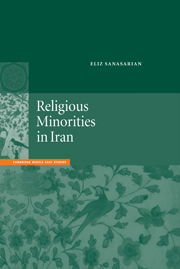Book contents
- Frontmatter
- Contents
- List of illustrations
- List of tables
- Preface
- Acknowledgments
- Notes on transliteration and bibliography
- Glossary
- Introduction: an overview of politics and society
- 1 Ethnic anatomy and politics of non-Muslim minorities
- 2 The Assembly of Experts: debut in the year of destiny
- 3 Policy sphere of recognized religious minorities
- 4 Distinctions and designations as policy output
- 5 Prevalent responses of recognized religious minorities
- Conclusion: the perils of marginality
- Notes
- Bibliography
- Index
- Titles in Series
3 - Policy sphere of recognized religious minorities
Published online by Cambridge University Press: 22 September 2009
- Frontmatter
- Contents
- List of illustrations
- List of tables
- Preface
- Acknowledgments
- Notes on transliteration and bibliography
- Glossary
- Introduction: an overview of politics and society
- 1 Ethnic anatomy and politics of non-Muslim minorities
- 2 The Assembly of Experts: debut in the year of destiny
- 3 Policy sphere of recognized religious minorities
- 4 Distinctions and designations as policy output
- 5 Prevalent responses of recognized religious minorities
- Conclusion: the perils of marginality
- Notes
- Bibliography
- Index
- Titles in Series
Summary
On the surface, the theocratic state granted the recognized religious minorities (RRMs) the same rights they had held before. Each enjoyed political representation, and their communities were guaranteed freedom of religion, language, and culture. The new regime, solely based on its constitution, could rightly claim a policy of continuity vis-à-vis the Armenians, the Assyrians and Chaldeans, the Zoroastrians, and the Jews. The exclusion of the Bahais was also consonant with past practice.
In reality life became more taxing and complex for the minorities. Readers should keep in mind the impact of the Revolution and the subsequent eight-year Iran–Iraq War as intervening variables in the analysis presented in this and the next two chapters. Just as important is the use of religion as a political ideology, which led to contradictions, fusion of myth with reality, a struggle between religious principles and the quest for power, a breakdown of hierarchical order, and eventually unprecedented confusion on human rights. The end result was development of a sharp “us”–“them” distinction involving the Muslim citizens of Iran and the non-Muslims. In contrast to the previous regime which stressed homogenization, the Islamic Republic accepted pluralism but pursued either exclusion or subordination, with coercion or the threat of coercion, based on ideology. The theocratic character (fused with a strange version of leftist ideology) of the state had created a new set of relationships between the state and the religious minorities, constituting compartmentalization and segmentation.
- Type
- Chapter
- Information
- Religious Minorities in Iran , pp. 73 - 105Publisher: Cambridge University PressPrint publication year: 2000

